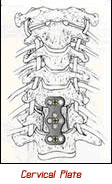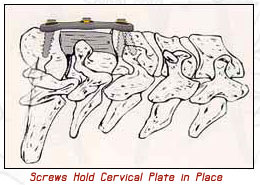|
:::
 |
 |
 |
 |

|
Cervical Plate |
 |
What is a cervical plate? |
|
A cervical plate is a medically designed implant used during spinal instrumentation and fusion procedures to provide neck stability. Cervical plates enhance the rate of fusion and, in some cases, may reduce the need for external bracing following surgery.
|
 |
How many plates are needed? |
|
Depending on the procedure and the number of spinal levels involved, one or more plates are implanted. The plate is held in place by screws set into adjacent vertebrae. |
 |
What are plates made of? |
|
Titanium is the metal of choice for many spinal implants including plates and screws because it has a high resistance to corrosion and fatigue, and is MRI compatible. |
 |
Are all plates the same size? |
|
  No. The plates and screws come in different lengths and screws are available at fixed or variable angles. Plates are designed for either anterior (front) or posterior (rear) placement. No. The plates and screws come in different lengths and screws are available at fixed or variable angles. Plates are designed for either anterior (front) or posterior (rear) placement.
Cervical plates are part of an instrumentation system, which provides the surgeon with specialized tools to perform a precision fit. The plates are manufactured to conform to the contour of the spine. When the plate requires adjustment, a contouring tool is used to customize the fit to the patient's cervical anatomy. |
 |
What causes cervical instability? |
|
Cervical instability can result from trauma, congenital deformity, or spinal reconstruction. Pseudoarthrosis, or the nonunion of bone (e.g. fracture), is another cause of cervical instability. How is a cervical plate used? Cervical fusion may be performed to relieve pressure on nerves, nerve roots or the spinal cord. During the procedure, the offending element (e.g. intervertebral disc) is removed, the empty space is filled with bone graft, and a cervical plate is securely fit covering the bone graft. The cervical plate keeps the bone graft in place and provides stability between the vertebrae above and below the graft site. This stability facilitates fusion - a joining of bony structures.
|
|
 |
|
 |
|